🪙 Behind the Names: Origins and Creators

Imagine a world where two superheroes of the digital realm were born – one hailed from an idea minted in the mysterious shadows by an enigmatic figure known as Satoshi Nakamoto, who launched Bitcoin in 2009, laying the cornerstone for what would become the first ever digital gold. This was a time when the idea of virtual money was merely a whisper in the tech corridors. Enter Ethereum, conceived by a young visionary, Vitalik Buterin, and his team in 2015, with dreams bigger than just creating another form of digital money. Ethereum was built as a platform to perform magic tricks – well, not exactly, but to run special applications called smart contracts that could do business without needing a middleman. Both creators, though miles apart in their approach, shared a common quest: to revolutionize how we perceive and use money on the internet. These origin stories mark the beginning of their distinct paths, each navigating the digital wilderness to shape what we now understand as the cryptocurrency space.
| Cryptocurrency | Creator | Launch Year |
|---|---|---|
| Bitcoin | Satoshi Nakamoto | 2009 |
| Ethereum | Vitalik Buterin & Team | 2015 |
💾 Ethereum Vs. Bitcoin: the Tech Foundations
At the heart of the digital currency world, Ethereum and Bitcoin are often mentioned in the same breath, yet their foundations could not be more different. Think of Bitcoin as the original pioneer, setting up camp in the digital wilderness with its blockchain technology—a secure, unchangeable digital ledger. It’s pretty much like a super secure, digital stone tablet where all transactions are recorded. Bitcoin’s main goal? To be digital gold, a new kind of money. Now, enter Ethereum. It’s like the inventive newcomer who not only wants to keep a ledger but also build a whole amusement park on the blockchain land. Ethereum introduces smart contracts, which are like automatic agreements that execute when certain conditions are met, opening a world of possibilities beyond just transactions.
The contrast doesn’t end with their basic utilities; it seeps into their very architecture and intent. While Bitcoin is a master at securely recording transactions, Ethereum takes it a step further by being a platform where developers can build decentralized applications (DApps). These DApps can do everything from managing complex financial agreements to running decentralized social media platforms. And if you’re curious about how other cryptocurrencies stack up, you might find it interesting to explore how Litecoin fits into this expansive landscape. Dive deeper into the topic at https://wikicrypto.news/decoding-litecoin-mining-a-deep-dive-into-the-numbers. This blending of technology and purpose showcases the vibrant innovation happening in the world of digital currencies, where the potential extends far beyond just being a new form of money.
💰 Let’s Talk Money: Value and Investments

When we peek into the world of digital money, Ethereum and Bitcoin stand out not just for their fame but for their financial tales too. Picture Bitcoin as the firstborn of this digital family, attracting investors with its gold-like status. It’s not just a form of money but also a haven for those looking to keep their wealth in something that feels stable and precious. Ethereum, on the other hand, is like the versatile younger sibling, always buzzing with ideas. Its currency, Ether, acts as the fuel for its broader ambitions to not just be money but to power a vast network of applications. This difference in vision reflects in the way people invest in them. While Bitcoin captures hearts as a digital gold, Ethereum draws those intrigued by the technology’s potential to change how we interact with the digital world.
Investing in them feels different too. Bitcoin, with its limited number, has a charm that comes from scarcity, driving its value up as more people want a piece of this digital gold. Ethereum, however, thrives on the endless possibilities it promises, making its value tied more to the endless projects and innovations it hosts. Whether you lean towards the solid allure of Bitcoin or the dynamic promise of Ethereum, the adventure is in not just watching their value but understanding the unique stories they tell in the tapestry of digital finance.
🚀 Speed and Space: Transaction Tales

Imagine sending a letter across the globe and it reaching its destination almost instantly, vs. the old-school way where it could take days. That’s a bit like comparing how Ethereum and Bitcoin handle transactions, a key aspect where they really differ. Bitcoin, the pioneer of digital currency, moves a bit like a tortoise, processing transactions at a slower pace, taking about 10 minutes per transaction. This might not sound like a lot, but in the fast-paced digital world, it’s a considerable delay. On the other side, Ethereum is more like the hare, with a speedier approach, completing transactions in mere seconds or minutes. This speed comes from the way Ethereum is designed, making it more suited for a broader range of digital applications. But it’s not just about speed; it’s also about how much can be carried at once – the ‘space’. Bitcoin is a bit like an old, narrow road, limiting the number of transactions that can go through at any given time, while Ethereum is akin to a wide highway, enabling more transactions to flow smoothly. This blend of speed and space gives Ethereum an edge for those looking to do more than just send and receive digital currency. For anybody diving into the world of digital currencies, knowing how these two giants operate can be invaluable, especially when considering projects that might require the swift and efficient handling of many transactions. For a deeper understanding, especially on how Ethereum is expanding its capabilities, check out litecoin price today, which offers insights into the revolutionary impact of Ethereum’s smart contracts on digital agreements and transactions.
🌍 Beyond Money: Unique Uses and Projects
Ethereum and Bitcoin aren’t just digital wallets bursting with virtual coins; they’re platforms for a kaleidoscope of projects and innovations. Picture Ethereum as a bustling city where developers build everything from smart contracts that execute agreements like magic, to decentralized apps (dApps) that run on a blockchain, ensuring they’re open to everyone and owned by no one. It’s a playground for ideas that extend far beyond currency, like creating digital art tokens or running autonomous organizations. On the flip side, Bitcoin maintains a focus on being digital gold, a secure store of value. While its primary use remains a form of payment and investment, its simplicity is its strength, offering unmatched security and a robust network effect, solidifying its place as the cornerstone of the digital currency world.
| Feature | Ethereum | Bitcoin |
|---|---|---|
| Primary Use | Smart contracts, dApps, digital tokens | Digital currency, store of value |
| Innovation Scope | High – Supports a wide array of applications | Moderate – Focused on financial transactions |
| Community Engagement | Extensive – Developers and users constantly exploring new uses | Targeted – Primarily investors and those interested in digital currency |
Ethereum’s versatility has birthed projects that can revolutionize industries by offering transparent, tamper-proof systems. Imagine voting systems where each vote is verifiable and untouchable by hackers, or supply chains where you can trace the journey of your coffee beans from the farm to your cup. Bitcoin, while not built for such a wide application range, has spurred a financial revolution, prompting the exploration of blockchain technology across the globe. Both networks have laid the groundwork for a future where the digital and physical worlds blend more seamlessly, proving that their impact stretches far beyond just being online money.
🛡️ Security Smackdown: Battling the Hackers

In the digital world, the battle against hackers is like an endless game of cat and mouse 🐭🐱. Ethereum and Bitcoin, as two of the leading stars in the cryptocurrency universe, have their own strategies to keep the bad guys at bay. It’s a bit like securing a treasure chest; both blockchains use complex mathematical puzzles, which are really hard to solve. This ensures that the treasure (or in this case, digital currency) stays safe. However, the approaches they take can be quite different. Bitcoin, being the first of its kind, set the stage with its rock-solid security foundations. The blockchain acts like a super strict guard, checking each transaction meticulously.
Ethereum, on the other hand, not only focuses on safeguarding money but also secures smart contracts—these are like agreements that execute automatically when certain conditions are met, opening doors to a multitude of applications beyond just transactions 📜💼. As technology evolves, so does the creativity of hackers, making security a top priority for both platforms. They constantly update and fortify their defenses to protect users. While no system can claim to be 100% secure, Ethereum and Bitcoin work tirelessly to stay several steps ahead of hackers. Curious about the scope of digital currencies beyond Ethereum? Check out what is ethereum to explore how much litecoin has been mined, a key metric in understanding the broader crypto landscape.
